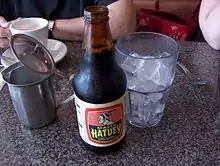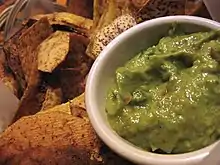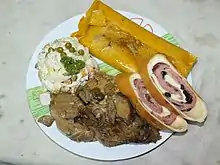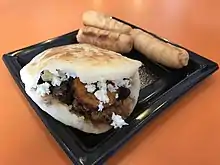Venezuelan food
Venezuelan food is about the many foods made and eaten in Venezuela. Most foods came from as a mix of European[1] (Mostly from the Mediterranean sea), African, and Indigenous dishes.[2] The most well known dish is the Arepa, a type of flat bun made with cornmeal (It could also be made with wheat flour[3]) which is eaten as a side or main dish filled with other foods. Other well known foods are pan de jamón, tequeños, pabellón criollo, and hallacas.
Different Venezuelan regions have different foods that are eaten. The most common food ingredients used are:[1][4]
- Grains and legumes: rice, corn, lentils, beans, peas, and other grains.
- Tubers and roots:[5] potatoes, yams, sweet potatoes, cassava, and Chinese squash.
- Meats: beef, chicken, hen, goat meat, pork, chigüire (capybara), venison, and a wide variety of fish and shellfish.
- Tropical fruits: mango, banana, papaya, guava and passion fruit.
Main foods


The foods most eaten in most parts of Venezuela are:
- Arepa
- Cachapa[2]
- Cachitos
- Caraotas negras
- Chicharrón
- Chupe Andino
- Ensalada de pollo (Chicken salad)
- Hallaca
- Huevos pericos
- Hervido de gallina (Hen soup))
- Mandoca
- Mondongo
- Pabellón criollo[6]
- Pastel de pollo (Chicken pot pie)
- Polvorosa de pollo
- Pastelitos
- Pasticho - A type of lasagne
- Polenta - or funche
Regional foods

Because of how big the country is, the foods are different in each region. Usual foods of each regions are:
- Eastern Region: Seafood, such as fish, shellfish and lobsters, tubers such as yams, potatoes and Chinese squash, corn and beef are eaten in the south-plains region where there soft fresh cheeses (Guiana, de mano, clineja, mozzarella criolla, etc.) are also made. Fried or stewed fish are eaten with arepas, rice, salad, tostones or slices. Some European foods (such as clams with white wine, paella, etc.) are also eaten.
- Central-western Region: Meats such as goat and rabbit, cheeses are eaten there. The foods are mostly from indigenous and European influence. There is also a a lot of fast foods that came from Zulia, like, the patacón, tumbarrancho (a type of arepa) and fried wheat cakes. Its typical sweets include chimbos eggs, icaco candy, lemon and figs.
- Central Region: Foods commonly eaten are Chicken, stewed or roasted fish, rice, pasta, salads that come from Spanish, Italian, French, Portuguese and other European foods.
- Llanos Region: The foods there are similar to the foods in Brazil, Uruguay and Argentina. Beef and game animals, like venison, chigüire (capybara), limpet, Cuniculus paca, morrocoy, are commonly grilled or roasted. Corn is also eaten there, mostly for cachapas. Dairy foods are also made there.
- Andean Region: The foods are similar to the Colombian Andes. Potatoes, wheat, beef, sheep, chicken, little fish except cultivated trout, from European foods are commonly eaten there.
Fresh or marinated vegetables, like aubergines, pumpkins, potatoes are also commonly eaten as sides.
Drinks
Some popular drinks are:

- Beer[1][7]
- Malta
- Parchita (Passionfruit juice)
Snacks

Some foods commonly eaten as snacks are:
Breads

Some breads commonly eaten are:
- Casabe – a flatbread made with cassava starch.
- Pan dulce (sweet bread)
- Pan de jamón – A bread filled with ham, olives, and raisins that is commonly eaten during the Christmas season.
Desserts

Some desserts eaten in special events are:
- Alfajor – Corn cookie with arequipe and grated coconut
- Bienmesabe
- Brazo gitano (Spanish Swiss roll)
- Cannoli – often called "cannoli siciliano"
- Pudín de chocolate – chocolate pudding
- Dulce de Lechosa Green papaya slowed cooked in a syrup with cinnamon, cloves, and vanilla.[8]
- Mousse de chocolate
- Quesillo – A type of flan[8]
- Polvorosas – Butter cookies with cinnamon
Cheeses

Queso fresco (or queso blanco) is popular in South American countries like Venezuela. Other popular cheeses are Guayanés cheese, Palmita cheese, and queso de mano.[9]
Sauces

Some sauces commonly made and used are:
- Wasakaka (or Guasacaca) - A side similar to guacamole.[10]
- Mojo
- Ajicero criollo - A spicy sauce similar to pico de gallo.
- Katara - A spicy sauce.
Sauces from other countries, such as ketchup, mayonnaise, soy sauce, mustard, Worcestershire sauce, Tabasco, pink sauce, tartar sauce have also been popular.
Festive foods

The hallaca is a food eaten at the Christmas season, which begins at December 3.[11] Venezuelan families meet to prepare the food. During the parties, pan de jamón, pork leg, chicken salad, punch, wine, black cake, and other dishes are commonly eaten as a side.
Even though it can be found at markets, people usually like the homemade version. Newer generations like to change up the recipe a bit.[11]
References
- Kohnstamm, Thomas; Kohn, Beth (2007). Lonely Planet Venezuela. Lonely Planet. ISBN 978-1-74104-545-1.
- Long, Lucy M. (2015-07-17). Ethnic American Food Today: A Cultural Encyclopedia. Rowman & Littlefield. ISBN 978-1-4422-2731-6.
- "Cómo hacer arepas andinas | Arepas de trigo". Recetas ABC (in Spanish). 2016-08-24. Retrieved 2021-08-02.
- Brittin, Helen Clark (2011). The food and culture around the world handbook. Library Genesis. Boston : Prentice Hall. ISBN 978-0-13-507481-7.
- "Venezuela - Crops". countrystudies.us. Retrieved 2021-08-02.
- McCausland-Gallo, Patricia (2011-10-04). The Food and Cooking of Colombia and Venezuela: Traditions, Ingredients, Tastes, Techniques, 65 Classic Recipes. Anness Publishing. ISBN 978-1-903141-83-0.
- Armas, Juan Forero and Mayela (2016-04-29). "Beer Becomes the Latest Scarcity in a Venezuela Crippled by Shortages". The Wall Street Journal. ISSN 0099-9660. Retrieved 2021-08-02.
- "Venezuela Food, Typical Meals Desserts - Comida Tipica South America". southamerica.cl. Retrieved 2021-08-02.
- Brown, Bob (2009-01-01). The Complete Book of Cheese. The Floating Press. ISBN 978-1-77541-353-0.
- Novas, Himilce; Silva, Rosemary (2016-12-13). Latin American Cooking Across the U.S.A. Knopf Doubleday Publishing Group. ISBN 978-1-5247-3241-7.
- Boadas, Aura Marina (2007). "Exilio y desarraigo en la narrativa de renato rodríguez: Exile and uprooting in Renato Rodríguez narrative". Núcleo. 19 (24): 137–149. ISSN 0798-9784.
